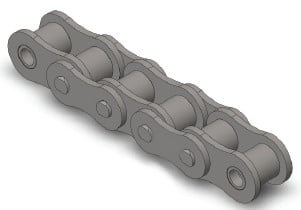The following actions need to be utilized to select chain and sprocket sizes, identify the minimal center distance, and calculate the length of chain essential in pitches. We are going to primarily use Imperial units (this kind of as horsepower) in this part having said that Kilowatt Capacity tables are available for each chain size inside the preceding segment. The assortment technique would be the very same irrespective of your units made use of.
Step one: Ascertain the Class of your Driven Load
Estimate which of the following most effective characterizes the issue with the drive.
Uniform: Smooth operation. Little or no shock loading. Soft start off up. Reasonable: Ordinary or reasonable shock loading.
Heavy: Serious shock loading. Frequent begins and stops.
Stage 2: Determine the Service Issue
From Table 1 below decide the proper Services Aspect (SF) for that drive.
Step three: Determine Style Power Necessity
Style Horsepower (DHP) = HP x SF (Imperial Units)
or
Style Kilowatt Energy (DKW) = KW x SF (Metric Units)
The Style and design Power Requirement is equal towards the motor (or engine) output electrical power occasions the Support Component obtained from Table 1.
Step 4: Make a Tentative Chain Selection
Produce a tentative selection of the necessary chain size from the following method:
1. If making use of Kilowatt electrical power – fi rst convert to horsepower for this phase by multiplying the motor Kilowatt rating by one.340 . . . This is often essential because the brief selector chart is proven in horsepower.
two. Locate the Style Horsepower calculated in step three by reading through up the single, double, triple or quad chain columns. Draw a horizontal line by way of this worth.
3. Locate the rpm of the compact sprocket about the horizontal axis with the chart. Draw a vertical line by this worth.
four. The intersection from the two lines must indicate the tentative chain variety.
Step 5: Choose the amount of Teeth to the Smaller Sprocket
After a tentative selection of the chain size is made we have to establish the minimal number of teeth essential to the compact sprocket demanded to transmit the Design and style Horsepower (DHP) or even the Style Kilowatt Power (DKW).
Phase six: Figure out the quantity of Teeth for the Substantial Sprocket
Use the following to determine the number of teeth to the substantial sprocket:
N = (r / R) x n
The amount of teeth on the substantial sprocket equals the rpm of the smaller sprocket (r) divided by the desired rpm of the big sprocket (R) occasions the quantity of teeth on the small sprocket. When the sprocket is also massive for the space readily available then various strand chains of a smaller pitch ought to be checked.
Phase seven: Ascertain the Minimal Shaft Center Distance
Utilize the following to determine the minimal shaft center distance (in chain pitches):
C (min) = (2N + n) /  six
six
The above is often a manual only.
Phase eight: Test the Ultimate Selection
Also be aware of any possible interference or other room limitations that could exist and adjust the assortment accordingly. On the whole quite possibly the most efficient/cost eff ective drive uses single strand chains. This is often for the reason that a number of strand sprockets are far more expensive and as may be ascertained from the multi-strand factors the chains grow to be less effi cient in transmitting energy since the number of strands increases. It is actually thus commonly best to specify single strand chains when achievable
Step 9: Figure out the Length of Chain in Pitches
Make use of the following to calculate the length on the chain (L) in pitches:
L = ((N + n) / two) + (2C) + (K / C)
Values for “K” may very well be identified in Table 4 on web page 43. Remember that
C would be the shaft center distance given in pitches of chain (not inches or millimeters and so on). If the shaft center distance is recognized within a unit of length the worth C is obtained by dividing the chain pitch (while in the same unit) by the shaft centers.
C = Shaft Centers (inches) / Chain Pitch (inches)
or
C = Shaft Centers (millimeters) / Chain Pitch (millimeters)
Note that whenever possible it’s most effective to employ an even amount of pitches as a way to stay clear of using an off set link. Off sets do not possess the same load carrying capability because the base chain and should be averted if feasible.
